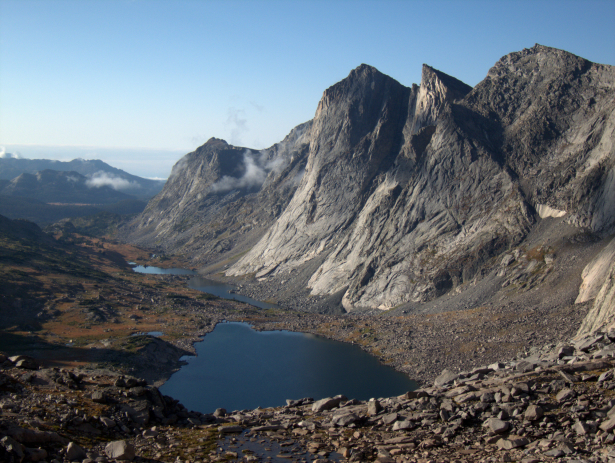Trail & Route Comparisons
The Wind River High Route is most comparable in the continental US to the Sierra High Route and Kings Canyon High Basin Route. In all cases, expect extensive off-trail travel, extreme vertical change, and in general a high-and-lonesome wilderness experience. If you have thru- or section-hiked these routes or similar, you’ll love the Wind River High Route.
There are a few important differences between these routes, however. In the Winds, the summer weather pattern is slightly less friendly — it rains more, and it rains more often. Travel across snow and/or glacial ice is also guaranteed; it’s not just an early-season phenomenon like in the High Sierra.
The High Route should be of interest to thru-hikers on the Continental Divide Trail, which unfortunately follows a relatively lackluster route on on the west side of the crest. If you have time and the ambition, slow down through the Winds — it will probably be the highlight of your CDT experience. Be aware, however, that the High Route is several notches more intense than the CDT: you are not guaranteed of success; the uncertainty and the necessary mental engagement will work you over; and your daily mileage will be shopped in half, plus/minus. Read more.


Sorry for inconvenience but just purchased the Wind River High Route and didn’t realize ( didn’t read all instructions) not advised to download on iPad. I’m a tugboat captain and currently offshore and away from home for my regular 14 days on/ 7 days off work schedule. Obviously I wasn’t successful in the download on my iPad so forwarded the email to my wife to download on her computer but message said I’ve reached my download limit for this file. Again I apologize for my ignorance and inconvenience but I’m hopeful to be able to get this route for my files. I’m doing the Highline in the Uintas this September and this trip will be next years adventure.
Thanks,
Dennis Pixton
If you’ve not already, send us an email and we’ll get it sorted out.
Hey Andrew,
I completed my first “off-trail” trip this past summer, doing the McGee Pass to Piute Pass section of the SHR. Loved it and felt very comfortable. Completed that in 3.5 days.
I am interested in doing loop 8 of your WRHR this August in 6 days. Do you think given my comfortability and pace on that section of the SHR, I shouldn’t have any stand-out concerns for tackling WRHR loop 8 in 6 days?
Thanks,
Seamus
The best indicator of how you’ll perform on future hikes is how you’ve performed on past ones. Specifically, how many horizontal miles or how much vertical change can you sustainably/comfortably manage each day?
More reading, https://andrewskurka.com/high-route-time-days-management-vertical/
Hi Andrew,
I am trying to do a bit of a different derivative of the Wind River Traverse (~80 miles from Green River to Big Sandy Lodge area on-trail), but I am hoping to utilize the shuttle from Trail Lake TH to Bruce’s Bridge since I will be alone. My plan was to start at Bruce’s Bridge and take the Middle Fork Trail to Pinto Park trail and then take the North Fork trail to connect to the Wind River Traverse trail near Pingora Peak. My one issue is that I need to divert from the Wind River Traverse around Mount Helen to connect myself to the Gannett Peak trail where I will take Glacier trail to finish at Trail Lake TH where my car will be waiting. Do you have any suggestions regarding connecting the Wind River Traverse to Gannett Peak trail? My main concern is crossing that area safely and avoiding snow travel if possible (I do not have much experience with this). Any recommendations, and an assessment of the feasibility of this plan, are greatly appreciated. Thanks!
Indian Pass and the Knife Point Glacier is the easiest option for connecting the west and east sides of the Continental Divide in that area. However, it’s not an easy pass, on absolute terms. It’s a big climb from the west side, involves crossing the edge of a rapidly melting glacier (usually just a snowfield nowadays, no crampons or axe advised) and its talus-covered terminal moraine below before linking up with social trails that eventually lead to the Glacier Trail.
Thank you for your insight Andrew. It looks like Knife Point Glacier’s runoff runs through the glacier’s terminal moraine and feeds the North fork of Bull Lake Creek; just North (~1 mile as the crow flies) of where this confluence is is yet another Indian Pass. It looks like pretty steep to get this other Indian Pass from the North fork of Bull Lake Creek to get to the Upper Dry Creek trail (these trails connect to the Glacier trails, and I assume these are the “social trails” that you were referencing). Do you have a recommendation in how to safely get from the terminal moraine of Knife Point Glacier to Upper Dry Creek trail? Thank you again for your help I really appreciate it.
You need to go over the mapped Indian Pass, too.
If you’re concerned about these off-trail sections, I’d humbly suggest:
1. Planning a different route with more reliable travel.
2. Have a Plan B in case your skilled prove inadequate for these sections.
3. Go hiking with someone who is skilled on this terrain so that you can gain confidence and competence when doing it on your own.
Thank you Andrew. I will definitely plan some exit strategies if both Indian Passes prove too much for me to deal with solo. I appreciate your concern.
Ultimately though, both Indian Passes are passable without needing climbing gear? Class 4 scrambling is the threshold I am comfortable with. Let me know if that is the case.